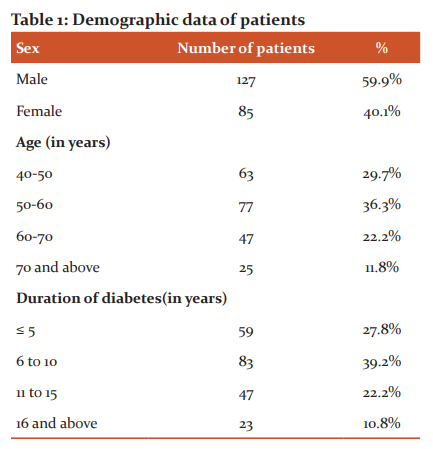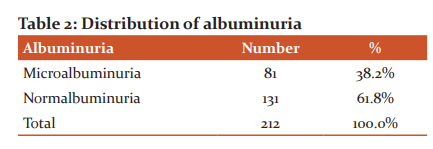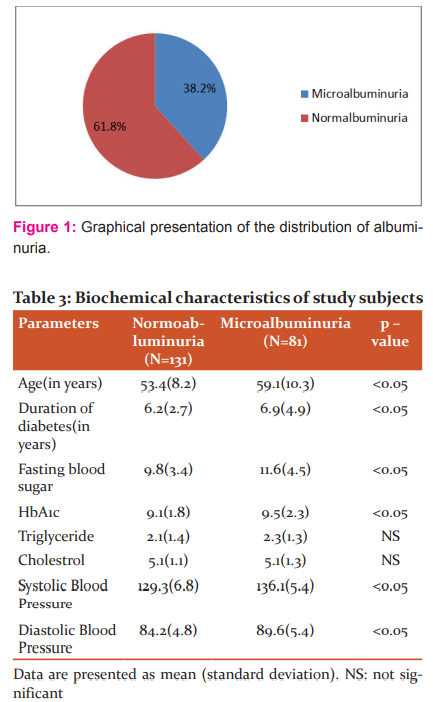IJCRR - 12(20), October, 2020
Pages: 42-45
Date of Publication: 27-Oct-2020
Print Article
Download XML Download PDF
Prevalence of Microalbuminuria in Type 2 Diabetes Mellitus: A Cross-sectional Study in Central India
Author: Gajanan V. Wasalwar, D.S. Wasnik
Category: Healthcare
Abstract:Introduction: Type 2 diabetes mellitus(T2DM) is the most common disease that occurs when the body becomes insulin resistant or is not producing enough insulin. Nearly 30% of type 1 diabetes mellitus (DM) and about 25% of T2DM patients suffer from diabetic nephropathy. It is observed that there is an increase in urinary extraction of albumin i.e. microalbuminuria in the early phase of diabetic neuropathy. In diabetic nephropathy as well as morbidity and mortality by cardiovascular disease, microalbuminuria is one of the early markers. The present study is undertaken to know the presence of microalbuminuria in T2DM cases of Indian population living in central India. Material and Methods: Present cross-sectional study on 212 patients diagnosed with type 2 diabetes mellitus study was done at Govt. Medical College Chandrapur in collaboration with IGMC Nagpur. Criteria laid by American Diabetes Association (ADA) was used to define diabetes. Microalbuminuria was diagnosed if in albumin to creatinine ratio in urine ranged between 30-300mg/g. Results: Prevalence of microalbuminuria in the present study was observed to be 38.2%. Various parameters viz. age, duration of diabetes, fasting blood sugar, blood pressure significantly differed between those who had microalbuminuria vs in those with normoalbuminuria. Conclusion: In our study, 81 patients among 212 patients were diagnosed with albuminuria with the prevalence of 38.2% similar to that reported in a study of southern India. The high prevalence of diabetes in India indicates that it is necessary to detect diabetes early to reduce the burden of diabetic kidney disease in future.
Keywords: T2DM, ADA, Microalbuminuria, Heart, Blood vessels, Eyes, Kidneys and nerves
Full Text:
INTRODUCTION:
Diabetes mellitus (DM) is a chronic, metabolic condition associated with elevated blood glucose (or blood sugar) levels, resulting in a significant heart problem, blood vessels, lungs, kidneys and nerves over time. Type 2 diabetes mellitus(T2DM) is the most common disease that occurs when the body becomes insulin resistant or is not producing enough insulin. The prevalence of T2DM has raised significantly in countries of all income levels during the past three decades. Globally diabetes has affected nearly 422 million people. A major proportion of people with the disease living in middle- and low-income countries[i]. About 109 million people are expected to be affected by diabetes by 2035 in India, according to the International Diabetes Federation (IDF)[ii].
T2DM, one of the major causes of mortality as well as morbidity and globally prevalent is considered to be a major risk factor for cardiovascular events[iii]. Nearly 30% of type 1 diabetes mellitus (DM) and about 25% of T2DM patients suffer from diabetic nephropathy. It is observed that there is an increase in urinary extraction of albumin i.e. microalbuminuria (MA) in the early phase of diabetic neuropathy. An only sensitive assay for urinary albumin can detect microalbuminuria. In about 30-40% of T2DM patients, abnormal levels of urinary albumin are observed. Microalbuminuria is an independent risk factor for cardiovascular disease and an early marker for diabetic nephropathy3. Excess secretion of urinary albumin may represent a more severe vascular damage compared to renal microvascular injury[iv]. Globally diabetic nephropathy is the top cause of end-stage renal disease and it has been proven that failure of the kidney is a major cause of death in T2DM patients[v],[vi].
Diabetic neuropathy is developed by various stages including frank proteinuria (macroalbuminuria), hyperfiltration and microalbuminuria (MA). In diabetic nephropathy as well as morbidity and mortality by cardiovascular disease, MA is one of the early markers[vii]. Albumin levels of 30 to 300 mg in urine collected for 24 hours characterizes microalbuminuria[viii],9. Nearly half of the cases reach last-stage renal disease in 7 to 10 years when noticeable proteinuria is present. MA may be present at the time of diagnosis in T2DM patients which is more commonly accompanied by hypertension. In Type 2 diabetes (T2DM) patients microalbumin present in urine is probably an important early sign indicating the onset of systemic vasculopathy and is associated with damage of organs like brain, kidney and heart 6,10.
All over the world, India has the highest number of patients suffering from diabetes which are further expected to rise in coming years 11. Therefore it is necessary to conduct studies on complications related to diabetes to evaluate the burden of disease. The present study is undertaken to know the presence of microalbuminuria in T2DM cases of Indian population living in central India.
MATERIAL AND METHODS:
The present study was done at Govt. Medical College Chandrapur in collaboration with IGMC Nagpur. This cross-sectional study was done on 212 subjects attending medicine OPD who were diagnosed with T2DM. The present study was carried out from October 2019 to January 2020. The following criteria laid by the American Diabetes Association (ADA)12 was used to define diabetes:
-
Blood glucose(fasting) ≥ 126 mg/dL, where fasting is at least 8 hours with no intake of calories
-
HbA1C ≥ 6.5 %
-
During an oral glucose test plasma glucose (Two hours) ≥ 200mg/dl
-
Rand plasma glucose was greater than 200mg/dl in patients showing classical symptoms of hyperglycemia or its crisis.
Informed consent had been obtained from patients included in study and patients with DM type 1, pregnant women, macroalbuminuria congestive cardiac failure, primary kidney disease, infection of the urinary tract and patients with hypertension were excluded. Demographic details such as age, sex, duration of diabetes of patients were recorded. BMI (Body Mass Index) of patients was calculated from their height and weight and BMI < 25kg/m2 was considered as normal. The upper right arm was used to record blood pressure. It was recorded in sitting position after rest of 5 minutes with aid of mercury sphygmomanometer. If the systolic blood pressure and/or diastolic blood pressure exceeded 130 mmHg and 85 mmHg, the patient was attributed as hypertensive. Patients were further subjected to testing of blood sugar (fasting), glycosylated haemoglobin HbA1c, serum triglyceride and serum cholesterol. HbA1c < 7% was considered to be normal. The enzymatic method was used to determine blood sugar, cholesterol and triglyceride level. After fasting overnight, samples of urine were collected in the morning early. If the first sample of urine indicated macroalbuminuria, the subject was not considered in the study. Assessment of first urine was done to check if the gravity of urine exceeded 1.015 and the presence of hematuria and absence of infection of urine.
Microalbuminuria was diagnosed if in two of three readings the albumin to creatinine ratio in urine ranged between 30-300mg/g. If the albumin-creatinine ratio was <30mg/g, it was diagnosed as normoalbuminuric.
RESULTS:

In this study, a total of 212 patients were included among which 127(59.9%) were males and 85(40.1%) were females. Mean age of patients was observed to be 55.2 years with standard deviation (SD) of 7.1 years. Maximum patients 36.3% belonged to age group 50-60 years of age group and minimum 11.8 % of patients were of aged 70 years or above. The mean duration of diabetes was noted to be 6.3 years with SD of 2.6 years. 39.3% of patients had diabetes from 6 to 10 years while 10.8 % of patients suffered from diabetes from more than 16 years ( Table 1,2).

In this study, it was observed that 81(38.2%) patients were diagnosed with microalbuminuria, while 131(61.8%) patients had normoalbuminuria (figure 1 and table 3).

Patients were grouped as normoalbuminuria(N=131) and microalbuminuria(N=81) to test if there is any significant difference between various parameters is observed. It was noted that mean age, duration of diabetes, fasting blood sugar, HbA1c, blood pressure(systolic as well as diastolic) differed significantly among both groups, all reading for these parameters being higher in those diagnosed with microalbuminuria compared to normoalbuminuria. Mean cholesterol and triglyceride levels did not differ significantly among both groups in this study.
DISCUSSION:
In the present study, 212 patients were included who were diagnosed with type 2 diabetes mellitus. Among 212 patient’s majority of patients were masculine 127(59.9%) and 85(40.1%) were feminine (table no 1 and 3). The present study was aimed at knowing the prevalence of microalbuminuria in T2DM patients. Diagnosis of MA was done based on albumin creatinine ratio, if it exceeded 30mg/g, microalbuminuria was present.
In our study, 81 patients among 212 patients were diagnosed with albuminuria with the prevalence of 38.2% (table no 2, Fig no 1). A study was done by Udit Narang et. al. in North India reported that microalbuminuria was present in 39%13 patients of T2DM. In a similar study done by Mohan MM et al. in southern India reported the presence of microalbuminuria in 24.8% patients of type 2 diabetes mellitus14.
In this study significant difference was observed between mean age, duration of diabetes, fasting blood sugar, HbA1c, systolic blood pressure and diastolic blood pressure among normoalbuminuria and microalbuminuria group 15. All parameters were observed to be significantly high in the microalbuminuria group. Another study conducted in south India by A Varghese et al. reported similar results matching to our study where age, duration of diabetes, fasting blood sugar, HbA1c, blood pressure(systolic and diastolic) differ significantly among cases with presence and absence of microalbuminuria. Also, the study reported a prevalence of 36.3% of microalbuminuria in T2DM patients16,18. Some other studies revealed the prevalence of microalbuminuria of 31%19 in Mexican Americans, 26%20 in Pima Indians, 42% 21 in Nauruans and in Hispanic Americans it was 35%22 and in India study conducted by Phadnis, P showed 7.55% 23.
CONCLUSION:
In our study, 81 patients among 212 patients were diagnosed with albuminuria with the prevalence of 38.2% similar to that reported in a study of southern India. The high prevalence of diabetes in India indicates that it is necessary to detect diabetes early to reduce the burden of diabetic kidney disease in future.
References:
-
Diabetes, https://www.who.int/health-topics/diabetes#tab=tab_1, accessed on May 3, 2020
-
Ramachandran A, Snehalatha C, Ma RC. Diabetes in South-East Asia: an update. Diabetes Res Clin Pract. 2014;103:231-7.
-
Ajonish Kamble, Ranjit S. Ambad, Mangesh Padamwar, Anupam Kakade, Meenakshi Yeola. To study the effect of oral vitamin D supplements on wound healing in patient with diabetic foot ulcer and its effect on lipid metabolism. Int. J. Res. Pharm. Sci., 2020, 11(2), 2701-2706.
-
Review Dyslipidemia in patients with type 2 diabetes. relationships between lipids, kidney disease and cardiovascular disease. Battisti WP, Palmisano J, Keane WE Clin Chem Lab Med. 2003 Sep; 41(9):1174-81.
-
Kassab A, Ajmi T, Issaoui M, Chaeib L, Miled A, Hammami M. Homocysteine enhances LDL fatty acid peroxidation, promoting microalbuminuria in type 2 diabetes. Ann Clin Biochem; 2008;45:476-80.
-
Ranjit S. Ambad, Rakesh Kumar Jha, Lata Kanyal Butola, Nandkishor Bankar, Brij Raj Singh, Archana Dhok. Relationship between uric acid and creatinine in pre-diabetic and diabetic patients: Vidarbha region of Maharashtra. Int. J. Res. Pharm. Sci., 2020, 11(3), 3412-3417.
-
Jerums G, MacIsaac RJ. Treatment of microalbuminuria in patients with type 2 diabetes mellitus. Treat Endocrinol 2002;1:163-73.
-
American Diabetes Association: Standards of medical care in diabetes. Diabetes Care 28(Suppl. 1): S4–S36, 2005.
-
Bhinder, H.H.P.S., and T.K. Kamble. “The Study of Carotid Intima-Media Thickness in Prediabetes and Its Correlation with Cardiovascular Risk Factors.” Journal of Datta Meghe Institute of Medical Sciences University. 2018;13(2): 79–82.
-
Bhinder, H.H.P.S., and T.K. Kamble. “The Study of Carotid Intima-Media Thickness in Prediabetes and Its Correlation with Cardiovascular Risk Factors.” Journal of Datta Meghe Institute of Medical Sciences University. 2018;13(2): 79–82
-
Ramachandran A, Snehalatha C, Latha E, et al. Rising prevalence of NIDDM in an urban population in India. Diabetologia 1997; 40:232–237.
-
Standards of Medical Care in Diabetes--2019. Diabetes Care 2019;42:S13-28.
-
Udit Narang, Vipin Jagadhami, Mohit Singla, Kiran Kumar Singal, Rajat Agarwal, Madhav Arora. A study of the prevalence of microalbuminuria and diabetic retinopathy in rural patients presenting to a tertiary care hospital in North India. International Journal of Contemporary Medical Research 2019;6(8): H18-H22.
-
Mohan MM, Chandra Sekhar V. Prevalence and risk factors of microalbuminuria in type 2 diabetes mellitus. Int J Adv Med 2015;2:383-6.
-
Ranjit Sidram Ambad, Gaikwad S B, Anshula G, Nandkishor Banker. Polyherbal antidiabetic drug: An approach to cure diabetes. Int. J. Res. Pharm. Sci., 2020, 11(2), 2679-2683.
-
A Varghese, R Deepa, M Rema, V Mohan. Prevalence of microalbuminuria in type 2 diabetes mellitus at a diabetes centre in southern India. Postgrad Med J 2001;77:399–402.
-
Velayutharaj A., Muthumani L., Senthilnathan R., Rajendran S.M., Shivakumar R., Saraswathi R.. Significance of Secreted Frizzled Related Protein 4 (SFRP4) in Type 2 Diabetic and non Diabetic Subjects in the Rural Agricultural Population Who are Exposed to Pesticides for the Prediction of Diabetes Mellitus International Journal of Current Research and Review. 2018;10 (06): 07-09.
-
Suraj P Wagh, Shweta P Bhagat, Nandkishor Bankar, Karan Jain. Role of Vitamin-C Supplementation in Type II Diabetes Mellitus International Journal of Current Research and Review. 2020;12 (13): 61-64.
-
Haffner SM, Morales PA, Gruber MK, et al. Cardiovascular risk factors in non-insulin-dependent diabetic subjects with microalbuminuria. ArteriosclerThromb1993;13:205–10.
-
Nelson RG, Kunzelman CL, Pettit DJ, et al. Albuminuria in type 2 (non-insulin-dependent) diabetes mellitus and impaired glucose tolerance in Pima Indians. Diabetologia1989;32:870–6.
-
Hamman RF, Franklin GA, Mayer EJ, et al. Microvascular complication of NIDDM in Hispanics and non-Hispanic whites. Diabetes Care. 1991;14:655–63.
-
Vijay V, Snehalatha C, Shina K, et al. Familial aggregation of diabetic kidney disease in type 2 diabetes in south India. Diabetes Res Clin Pract. 1993;43:167–71.
-
Phadnis, P., M.A. Kamble, S. Daigavane, P. Tidke, and S. Gautam. “Prevalence and Risk Factors – Hemoglobin A1c, Serum Magnesium, Lipids, and Microalbuminuria for Diabetic Retinopathy: A Rural Hospital-Based Study.” JDMIMSU. 2017;12 (2): 121–32.
|






 This work is licensed under a Creative Commons Attribution-NonCommercial 4.0 International License
This work is licensed under a Creative Commons Attribution-NonCommercial 4.0 International License